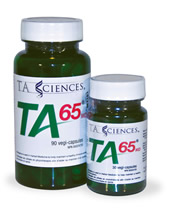| TA 65 the Science of Telomeres | |
Telomeres
Telomere News Telomere Length Could Predict Cold Virus Infection Risk A New View of Depression: an Ailment of the Entire Body
|
Telomeres The Rate of Leukocyte Telomere Shortening Predicts Mortality
Abstract: Telomere length (TL) has been proposed as a marker of mitotic cell age and as a general index of human organismic aging. Short absolute leukocyte telomere length has been linked to cardiovascular ‐ related morbidity and mortality. Our aim was to test whether the rate of change in leukocyte TL is related to mortality in a healthy elderly cohort. We examined a subsample of 236 randomly selected Caucasian participants from the MacArthur Health Aging Study (aged 70 to 79 years). DNA samples from baseline and 2.5 years later were assayed for mean TL of leukocytes. Percent change in TL was calculated as a measure of TL change (TLC). Associations between TL and TLC with 12‐year overall and cardiovascular mortality were assessed. Over the 2.5 year period, 46% of the study participants showed maintenance of mean bulk TL, whereas 30% showed telomere shortening, and, unexpectedly, 24% showed telomere lengthening. For women, short baseline TL was related to greater mortality from cardiovascular disease (OR = 2.3; 95% CI: 1.0 – 5.3). For men, TLC (specifically shortening), but not baseline TL, was related to greater cardiovascular mortality, OR = 3.0 (95% CI: 1.1 – 8.2). This is the first demonstration that rate of telomere length change (TLC) predicts mortality and thus may be a useful prognostic factor for longevity Telomere Length Trajectory and Its Determinants in Persons with Coronary Artery Disease: Longitudinal Findings from the Heart and Soul Study
Background: Leukocyte telomere length, an emerging marker of biological age, has been shown to predict cardiovascular morbidity and mortality. However, the natural history of telomere length in patients with coronary artery disease has not been studied. We sought to investigate the longitudinal trajectory of telomere length, and to identify the independent predictors of telomere shortening, in persons with coronary artery disease. Telomere-dependent senescent phenotype of lens epithelial cells as a
Cataract formation represents a serious problem in the elderly and has a large impact on healthcare budget. Aging and cataract formation are relatively complex phenomena, both in vivo and in vitro.Telomeres are special structures at the end of chromosomes. They shorten during each round of replication, and this has been characterized as a mitotic counting mechanism. Our review analysis in this work shows that the rate of telomere shortening in human lens epithelial cells during aging and cataract formation is modulated by oxidative stress as well as by differences in antioxidative defense capacity of the normal and cataractous crystalline lenses. Telomerase is not an oncogene
In the decade since the telomere hypothesis of cellular aging was proposed, the two essential genes for human telomerase were cloned and characterized, allowing experimental proof of the causal relationships between telomere loss and replicative senescence, and telomerase activation and immortalization. These relationships were established using a variety of cultured human cell types from both normal and tumor tissues, and were largely confrmed in the telomerase knockout mouse. Taken together, the data provide strong support for the potential utility of telomerase detection and inhibition for cancer, and telomerase activation for degenerative diseases. Telomerase gene therapy in adult and old mice delays aging and increases longevity
A major goal in aging research is to improve health during aging. In the case of mice, genetic manipulations that shorten or lengthen telomeres result, respectively, in decreased or increased longevity. Based on this, we have tested the effects of a telomerase gene therapy in adult (1 year of age) and old (2 years of age) mice. Treatment of 1- and 2-year old mice with an adeno associated virus (AAV) of wide tropism expressing mouse TERT had remarkable beneficial effects on health and fitness, including insulin sensitivity, osteoporosis, neuromuscular coordination and several molecular biomarkers of aging. Importantly, telomerase - treated mice did not develop more cancer than their control littermates, suggesting that the known tumorigenic activity of telomerase is severely decreased when expressed in adult or old organisms using AAV vectors. Do Depression and Stress Accelerate Cell Aging: Telomeres and Telomarse
Depression has been likened to a state of "accelerated aging", and depressed individuals have a higher incidence of various diseases of aging,
Scientists Successfully Test 1st Gene Therapy Against Aging-Associated Decline
This study "shows that it is possible to develop a telomerase-based antiageing gene therapy without increasing the incidence of cancer", the authors affirm. "Aged organisms accumulate damage in their DNA due to telomere shortening, [this study] finds that a gene therapy based on telomerase production can repair or delay this kind of damage", they add. |
Telomeres Video
|
|


